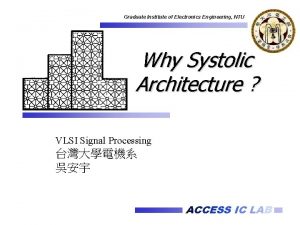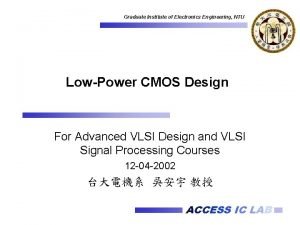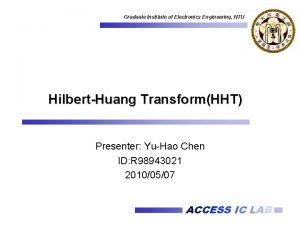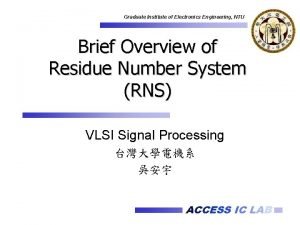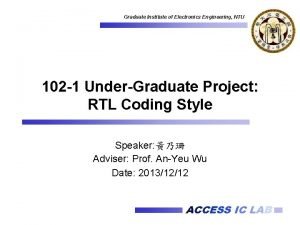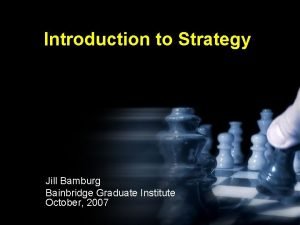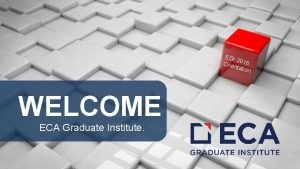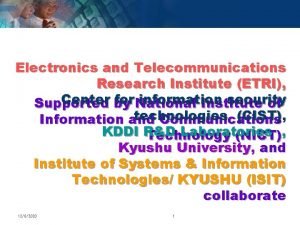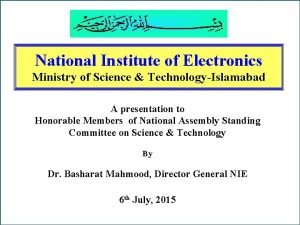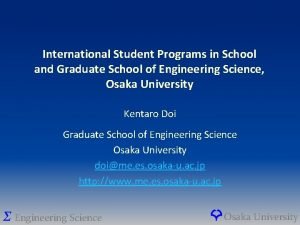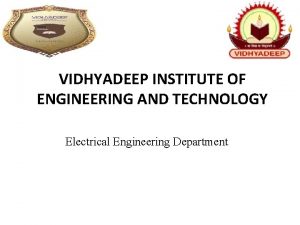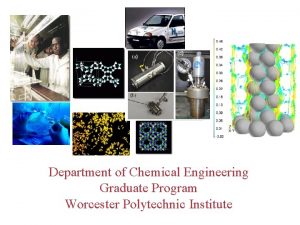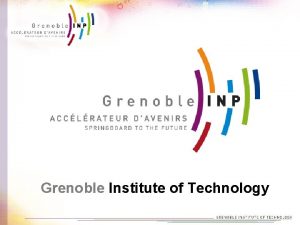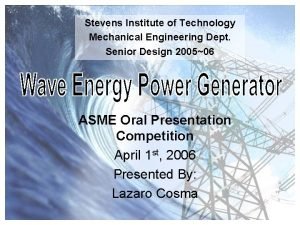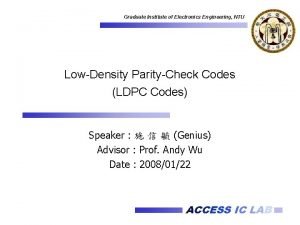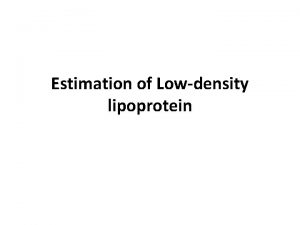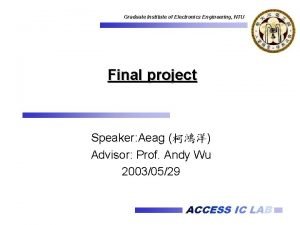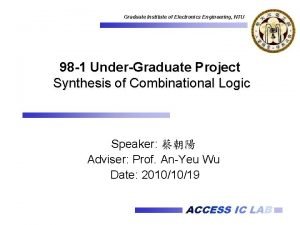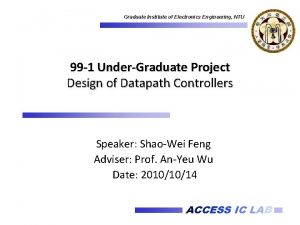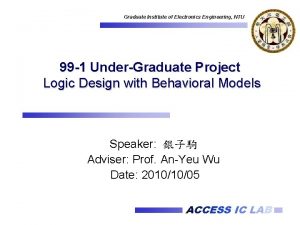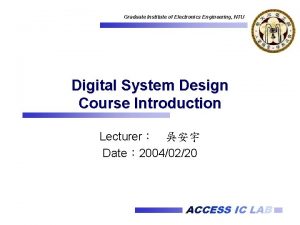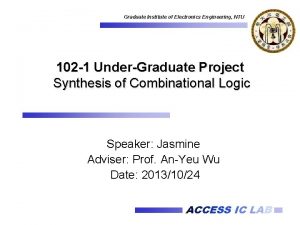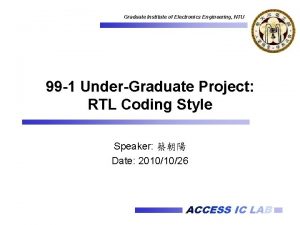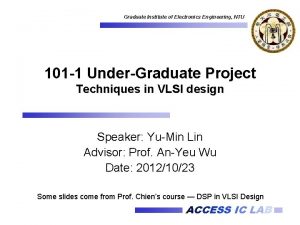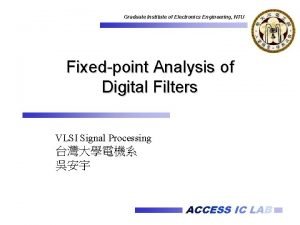Graduate Institute of Electronics Engineering NTU LowDensity ParityCheck












![ACCESS IC LAB Graduate Institute of Electronics Engineering, NTU Reference [1] Xiao-Yu H u, ACCESS IC LAB Graduate Institute of Electronics Engineering, NTU Reference [1] Xiao-Yu H u,](https://slidetodoc.com/presentation_image_h/b3ce32db43d2f30ab122fdb9515ecee1/image-13.jpg)
- Slides: 13

Graduate Institute of Electronics Engineering, NTU Low-Density Parity-Check Codes Speaker : 詹承洲 Advisor : Prof. Andy Wu Date : 2007/03/07 ACCESS IC LAB

ACCESS IC LAB Graduate Institute of Electronics Engineering, NTU Outline Introduction to LDPC Codes Problem Statement What You Will Learn Expected Results Reference 2

ACCESS IC LAB Graduate Institute of Electronics Engineering, NTU Communication Channel Noise 3

ACCESS IC LAB Graduate Institute of Electronics Engineering, NTU Digital Communication System Transmitter Information Source LDPC codes JPEG, MPEG Source Encoder BPSK, QPSK, 16 -QAM, 64 -QAM rb Channel Encoder rc Modulator rs Channel Receiver Data Sink Source Decoder Channel Decoder Demodulator 4

ACCESS IC LAB Graduate Institute of Electronics Engineering, NTU Motivation n LDPC codes were first introduced by Gallager in 1962 n LDPC codes was rediscovered by Mac. Kay in 1993: n Excellent error-correcting performance near the Shannon limit BER LDPC codes Only 0. 045 d. B gap SNR(d. B) 5

ACCESS IC LAB Graduate Institute of Electronics Engineering, NTU Applications Wi. MAX system IEEE 802. 11 n NSC 3 C IT Project NTU/MTK Project 6

ACCESS IC LAB Graduate Institute of Electronics Engineering, NTU Introduction to LDPC Codes n Parity check matrix : sparse matrix B 1 B 2 B 3 B 4 B 5 B 6 B 7 B 8 B 9 C 1 C 2 C 3 C 4 C 5 C 6 n Bipartite graph B 1 B 2 C 1 B 3 C 2 B 4 C 3 B 5 B 6 C 4 B 7 C 5 B 8 C 6 B 9 Bit nodes (columns) Check nodes (rows) 7

ACCESS IC LAB Graduate Institute of Electronics Engineering, NTU Our Achievement JSSC’ 02–(1024, 512)-52. 5 mm 2 Our chip for Wi. MAX system (2304, 1152) -- 8 mm 2 8

ACCESS IC LAB Graduate Institute of Electronics Engineering, NTU Problem Statement Algorithm domain: Complex operation of VNU and CNU Low hardware utilization efficiency Inefficient termination scheme Architecture domain : Large area cost Need some high throughput approaches High power consumption 9

ACCESS IC LAB Graduate Institute of Electronics Engineering, NTU What You Will Learn Concept of channel coding The most powerful channel coding till now – LDPC Fixed-point analysis Evaluation of the performance of a channel coding 10

ACCESS IC LAB Graduate Institute of Electronics Engineering, NTU Expected Results Paper survey and acquaintance with LDPC codes C model of LDPC codes Advanced schedule Algorithm domain Operation function Termination Scheme Architecture domain Critical path shortening 11

ACCESS IC LAB Graduate Institute of Electronics Engineering, NTU Background Needed Linear algebra C programming Matlab (Optional) DSP or Communication Systems (Optional) 12
![ACCESS IC LAB Graduate Institute of Electronics Engineering NTU Reference 1 XiaoYu H u ACCESS IC LAB Graduate Institute of Electronics Engineering, NTU Reference [1] Xiao-Yu H u,](https://slidetodoc.com/presentation_image_h/b3ce32db43d2f30ab122fdb9515ecee1/image-13.jpg)
ACCESS IC LAB Graduate Institute of Electronics Engineering, NTU Reference [1] Xiao-Yu H u, Eleftheriou E. ; Arnold D. -M. , Dholakia A. , “Efficient Implementations of the Sum-Product Algorithm for Decoding LDPC Codes, ” Global Telecommunications Conference, Vol. 2, pp. 1036 – 1036 E, Nov. 2001
 Graduate institute of electronics engineering
Graduate institute of electronics engineering 吳安宇
吳安宇 Graduate institute of electronics engineering
Graduate institute of electronics engineering Graduate institute of electronics engineering
Graduate institute of electronics engineering Graduate institute of electronics engineering
Graduate institute of electronics engineering Bainbridge graduate institute
Bainbridge graduate institute Eca graduate institute
Eca graduate institute Electronics and telecommunications research institute
Electronics and telecommunications research institute National electronics complex of pakistan
National electronics complex of pakistan Oussep osaka
Oussep osaka Vidhyadeep institute of engineering and technology
Vidhyadeep institute of engineering and technology Worcester polytechnic institute chemical engineering
Worcester polytechnic institute chemical engineering Saio grenoble
Saio grenoble Stevens institute of technology mechanical engineering
Stevens institute of technology mechanical engineering
